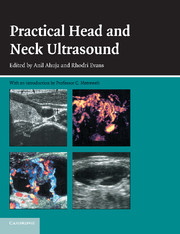Book contents
- Frontmatter
- Contents
- Contributors
- Introduction
- Acknowledgement
- CHAPTER 1 Anatomy and Technique
- CHAPTER 2 Salivary Glands
- CHAPTER 3 The Thyroid and Parathyroids
- CHAPTER 4 Lymph Nodes
- CHAPTER 5 Lumps and Bumps in the Head and Neck
- CHAPTER 6 The Larynx
- CHAPTER 7 What the Surgeon Needs to Know, and Why
- CHAPTER 8 Fine-Needle Aspiration or Core Biopsy?
- CHAPTER 9 Carotid and Vertebral Ultrasonography
- Index
CHAPTER 8 - Fine-Needle Aspiration or Core Biopsy?
- Frontmatter
- Contents
- Contributors
- Introduction
- Acknowledgement
- CHAPTER 1 Anatomy and Technique
- CHAPTER 2 Salivary Glands
- CHAPTER 3 The Thyroid and Parathyroids
- CHAPTER 4 Lymph Nodes
- CHAPTER 5 Lumps and Bumps in the Head and Neck
- CHAPTER 6 The Larynx
- CHAPTER 7 What the Surgeon Needs to Know, and Why
- CHAPTER 8 Fine-Needle Aspiration or Core Biopsy?
- CHAPTER 9 Carotid and Vertebral Ultrasonography
- Index
Summary
Introduction
Once started on the learning curve for head and neck ultrasound, the radiologist will rapidly approach the next hurdle – namely, how best to acquire a tissue diagnosis? Ultrasound lends itself to biopsy techniques in the neck, being far superior to magnetic resonance imaging (MRI) and computed tomography (CT) in this respect.
Which technique should be the first choice of the radiologist – fine-needle aspiration (FNA) or core biopsy? The straight answer is that FNA should be the initial choice in the majority of cases; the answer will be obtained in 80% of cases provided there is local cytological expertise. But, if FNA is so successful, what is the role for core biopsy? Core biopsy has two roles to play: to give an answer when the cytologist cannot, and to give a tissue diagnosis which may obviate the need for an open biopsy. Where histological expertise allows, oncologists may opt to treat lymphoma diagnosed and typed by a core biopsy rather than open biopsy. The benefit to the patient and clinician alike in speed of diagnosis and reduced morbidity is obvious.
Children are always a special case in radiology, and biopsy techniques are no exception. Core biopsy techniques are now so refined that biopsy is now possible in children without the use of sedation. This practice is not universal, but it is a development that should not be ignored.
The choice between core biopsy and FNA will always be governed by local factors and influences.
- Type
- Chapter
- Information
- Practical Head and Neck Ultrasound , pp. 129 - 144Publisher: Cambridge University PressPrint publication year: 2000



